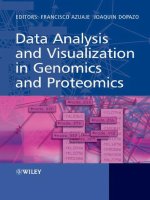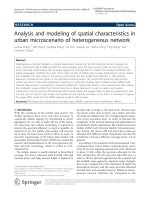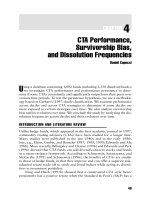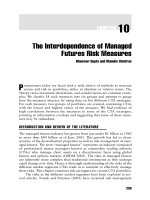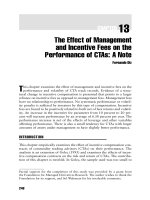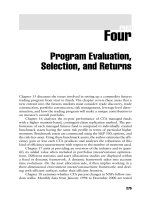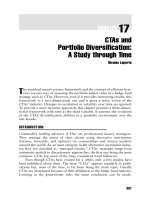Analysis and Modeling in GIS pps
Bạn đang xem bản rút gọn của tài liệu. Xem và tải ngay bản đầy đủ của tài liệu tại đây (1.78 MB, 46 trang )
1
07/07/14 Ron Briggs, UTDallas GISC 6381 GIS Fundamentals
Analysis and Modeling in GIS
2
07/07/14 Ron Briggs, UTDallas GISC 6381 GIS Fundamentals
GIS and the Levels of Science
Description:
Using GIS to create descriptive models of the world
representations of reality as it exists.
Analysis:
Using GIS to answer a question or test an hypothesis.
Often involves creating a new conceptual output layer, (or table or chart),
the values of which are some transformation of the values in the
descriptive input layer.
e.g. buffer or slope or aspect layers
Prediction:
Using GIS capabilities to create a predictive model of a real world
process, that is, a model capable of reproducing processes and/or
making predictions or projections as to how the world might appear.
e.g. flood models, fire spread models, urban growth models
3
07/07/14 Ron Briggs, UTDallas GISC 6381 GIS Fundamentals
The Analysis Challenge
•
Recognizing which generic GIS analytic capability (or
combination) can be used to solve your problem:
–
meet an operational need
–
answer a question posed by your boss or your board
–
address a scientific issue and/or test a hypothesis
Send mailings to property owners potentially affected by a proposed change
in zoning
Determine if a crime occurred within a school’s “drug free zone”
Determine the acreage of agricultural, residential, commercial and
industrial land which will be lost by construction of new highway corridor
Determine the proportion of a region covered by igneous extrusions
Do Magnitude 4 or greater sub-oceanic earthquakes occur closer to the
Pacific coast of South America than of North America?
Are gas stations or fast food joints closer to freeways?
Availability of Capabilities in GIS Software
•
Descriptive Focus: Basic Desktop GIS packages
–
Data editing, description and basic analysis
–
ArcView
–
Mapinfo
–
Geomedia
•
Analytic Focus: Advanced Professional GIS systems
–
More sophisticated data editing plus more advanced analysis
–
ARC/INFO, MapInfo Pro, etc.
Provided through extra cost Extensions
or professional versions of desktop packages
•
Prediction: Specialized modeling and simulation
–
via scripting/programming within GIS
»
VB and ArcObjects in ArcGIS
»
Avenue scripts in ArcView 3.2
»
AMLs in Workstation ARC/INFO (v. 7)
Write your own or download from ESRI Web site
–
via specialized packages and/or GISs
»
3-D Scientific Visualization packages
»
transportation planning packages e.g TransCAD
»
ERDAS, ER Mapper or similar package for raster
Capabilities move
‘down the chain’
over time.
In earlier generation
GIS systems, use of
advanced applications
often required learning
another package with
a different user
interface and
operating system
(usually UNIX).
5
07/07/14 Ron Briggs, UTDallas GISC 6381 GIS Fundamentals
Description and Basic Analysis
(Table of Contents)
•
Spatial Operations
Vector
–
spatial measurement
–
Centrographic statistics
–
buffer analysis
–
spatial aggregation
»
redistricting
»
regionalization
»
classification
–
Spatial overlays and joins
Raster
–
neighborhood
analysis/spatial filtering
–
Raster modeling
•
Attribute Operations
–
record selection
»
tabular via SQL
»
‘information clicking’
with cursor
–
variable recoding
–
record aggregation
–
general statistical
analysis
–
table relates and joins
6
07/07/14 Ron Briggs, UTDallas GISC 6381 GIS Fundamentals
Spatial measurements:
•
distance measures
–
between points
–
from point or raster
to polygon or zone boundary
–
between polygon centroids
•
polygon area
•
polygon perimeter
•
polygon shape
•
volume calculation
–
e.g. for earth moving, reservoirs
•
direction determination
–
e.g. for smoke plumes
Spatial operations: Spatial Measurement
Comments:
•
Cartesian distance via Pythagorus
Used for projected data by ArcMap measure tools
•
Spherical distance via spherical coordinates
Cos d = (sin a sin b) + (cos a cos b cos P)
where: d = arc distance
a = Latitude of A
b = Latitude of B
P = degrees of long. A to B
Used for unprojected data by ArcMap measure tools
•
possible distance metrics:
–
straight line/airline
–
city block/manhattan metric
–
distance thru network
–
time/friction thru network
•
shape often measured by:
•
Projection affects values!!!
perimeter
area x 3.54
= 1.0 for circle
= 1.13 for square
Large for complex shape
ArcGIS geodatabases contain automatic
variables:
shape.length: line length or
polygon perimeter
shape.area: polygon area
Automatically updated after editing.
For shapefiles, these must be calculated
e.g. by opening attribute table and applying
Calculate Geometry to a column (AV 9.2)
Distances depend on
projection.
Perimeter to area ratio
differs
22
)()(
jijiij
YYXXd −+−=
7
07/07/14 Ron Briggs, UTDallas GISC 6381 GIS Fundamentals
Spatial operations: Spatial Measurement
SHAPE AREA PERIMETER CNTY_ CNTY_ID NAME FIPS Shape Index
Polygon 0.265 2.729 2605 2605 Anderson 48001 1.50
Polygon 0.368 2.564 2545 2545 Andrews 48003 1.19
Polygon 0.209 2.171 2680 2680 Angelina 48005 1.34
Polygon 0.072 2.642 2899 2899 Aransas 48007 2.78
Polygon 0.233 1.941 2335 2335 Archer 48009 1.14
Polygon 0.233 1.941 2103 2103 Armstrong 48011 1.14
Polygon 0.299 2.278 2870 2870 Atascosa 48013 1.18
Polygon
Polygon 0.224 1.900 2471 2471 Dallas 48113 1.13
Polygon 0.222 1.889 2481 2481 Dawson 48115 1.13
Polygon 0.368 2.580 2106 2106 Deaf Smith 48117 1.20
Polygon 0.072 1.421 2386 2386 Delta 48119 1.50
Area and Perimeter measures are automatically maintained in the
attributes table for a Geodatabase or coverage. For a shapefile, you
need to apply Calculate Geometry to an appropriate column in the
attribute table (or convert to a geodatabase) .
The shape index can be calculated from the area and perimeter
measurements. (Note: shapefile and shape index are unrelated)
8
07/07/14 Ron Briggs, UTDallas GISC 6381 GIS Fundamentals
Spatial Measurement: Calculating the Area of a Polygon
)/2YY ( )X-(X
2112
1i
n
+
∑
=
0 10
5
0 10
5
0 10
5
0
10
5
2,3
7,7
7,3
6,2
4,7
Area=(2 x 4)/2=4
Area=(3 x 4)=12
Area=(5 x 1)/2=2.5
5
0 10
5
5
0 10
5
=
-
A
CB
=
-
The actual algorithm used obtains the area of A by
calculating the areas of B and C, and then subtracting.
The actual formulae used is as follows:
Its implementation in Excel is shown below.
The area of the above
polygon is 18.5, based on
dividing it into rectangles
and triangles. However,
this is not practical for a
complex polygon.
Area of triangle =
(base x height)/2
9
07/07/14 Ron Briggs, UTDallas GISC 6381 GIS Fundamentals
Spatial Operations:
Centrographic Statistics
•
Basic descriptors for spatial point distributions
•
Two dimensional (spatial) equivalents of standard descriptive statistics
(mean, standard deviation) for a single-variable distribution
Measures of Centrality (equivalent to mean)
–
Mean Center and Centroid
Measures of Dispersion (equivalent to standard deviation or variance)
–
Standard Distance
–
Standard Deviational Ellipse
•
Can be applied to polygons by first obtaining the centroid of each polygon
•
Best used in a comparative context to compare one distribution (say in
1990, or for males) with another (say in 2000, or for females)
10
07/07/14 Ron Briggs, UTDallas GISC 6381 GIS Fundamentals
Centroid and Mean Center
•
balancing point for a spatial distribution
–
analogous to the mean
–
single point representation for a polygon (centroid)
–
single point summary for a point distribution (mean center)
–
can be weighted by ‘magnitude’ at each point (analogous to weighted mean)
–
minimizes squared distances to other points, thus ‘distant’ points have bigger influence
than close points ( Oregon births more impact than Kansas births!)
–
is not the point of “minimum aggregate travel” this would minimize distances (not their
square) and can only be identified by approximation.
•
useful for
–
summarizing change over time in a distribution (e.g US pop. centroid every 10 years)
–
placing labels for polygons
•
for weird-shaped polygons,
centroid may not lie within polygon
centroid outside
polygon
n
Y
Y
n
X
X
n
i
i
n
i
i
∑∑
==
==
11
,
Note: many ArcView applications calculate
only a “psuedo” centroid: the coordinates of the
bounding box (the extent) of the polygon
Can be implemented via:
ArcToolbox>Spatial Statistics Tools>Measuring
Geographic Distributions>Mean Center
11
07/07/14 Ron Briggs, UTDallas GISC 6381 GIS Fundamentals
n
Y
Y
n
X
X
n
i
i
n
i
i
∑∑
==
==
11
,
0 10
5
0
10
5
2,3
7,7
7,3
6,2
4,7
Calculating the centroid of a
polygon or the mean center of
a set of points.
(same example data as
for area of polygon)
Calculating the weighted mean
center. Note how it is pulled
toward the high weight point.
∑
∑
∑
∑
==
==
i
n
i
ii
i
n
i
ii
w
Yw
Y
w
Xw
X
11
,
0 10
5
0
10
5
2,3
7,7
7,3
6,2
4,7
Median Center:
Intersection of a north/south and an
east/west line drawn so half of population
lives above and half below the e/w line, and
half lives to the left and half to the right of
the n/s line.
Same as “point of minimum aggregate
travel” the location that would minimize
travel distance if we brought all US residents
straight to one location.
Mean Center:
Balancing point of a weightless map, if equal
weights placed on it at the residence of every
person on census day.
Note: minimizes squared distances. The point
is considerable west of the median center
because of the impact of “squared distance” to
“distant” populations on west coast
Source: US Statistical Abstract 2003
For a fascinating discussion of the effect of
population projection see: E. Aboufadel & D.
Austin, A new method for calculating the
mean center of population center of the US
Professional Geographer, February 2006, pp.
65-69
13
07/07/14 Ron Briggs, UTDallas GISC 6381 GIS Fundamentals
Standard Distance Deviation
single unit measure of the spread or dispersion of a distribution.
•
Is the spatial equivalent of standard deviation for a single variable
•
Equivalent to the standard deviation of the distance of each point from the mean
center
•
Given by:
which by Pythagoras
reduces to:
the square root of the average squared distance
essentially the average distance of points from the center
We can also weight each point and calculate weighted standard distance
(analogous to weighted mean center.)
N
YYXX
n
i
n
i
cici
∑ ∑
= =
−− +
1 1
22
)()(
N
d
n
i
iC
∑
=1
2
14
07/07/14 Ron Briggs, UTDallas GISC 6381 GIS Fundamentals
Standard Distance Deviation Example
N
YYXX
sdd
n
i
n
i
cici
∑ ∑
= =
−− +
=
1 1
22
)()(
0 10
5
0
10
5
2,3
7,7
7,3
6,2
4,7
Circle with radii=SDD=2.9
Standard Deviational Ellipse: concept
•
Standard distance deviation is a good single measure of the dispersion of the
incidents around the mean center, but it does not capture any directional bias
–
doesn’t capture the shape of the distribution.
•
The standard deviation ellipse gives dispersion in two dimensions
•
Defined by 3 parameters
–
Angle of rotation
–
Dispersion along major axis
–
Dispersion along minor axis
The major axis defines the
direction of maximum spread
of the distribution
The minor axis is perpendicular to it
and defines the minimum spread
16
07/07/14 Ron Briggs, UTDallas GISC 6381 GIS Fundamentals
Standard Deviational Ellipse: example
For formulae for its calculation, see
Lee and Wong Statistical Analysis with ArcView GIS pp. 48-49 (1
st
ed.), pp 203-205 (2
nd
ed.)
There appears to be
no major difference
between the location
of the software and
telecommunications
industry in North
Texas.
Spatial Operations: buffer zones
•
region within ‘x’ distance units
•
buffer any object: point, line or
polygon
•
use multiple buffers at progressively
greater distances to show gradation
•
may define a ‘friction’ or ‘cost’ layer
so that spread is not linear with
distance
•
Implement in Arcview 3.2 with
Theme/Create buffers
in ArcGIS 8 with
ArcToolbox>Analysis Tools>Buffer
Examples
•
200 foot buffer around property
where zoning change requested
•
100 ft buffer from stream center
line limiting development
•
3 mile zone beyond city
boundary showing ETJ (extra
territorial jurisdiction)
•
use to define (or exclude) areas
as options (e.g for retail site)
or for further analysis
•
in conjunction with ‘friction
layer’, simulate spread of fire
polygon buffer
line
buffer
point
buffers
Note: only one layer is involved, but the
buffer can be output as a new layer
Criteria may be:
–
formal (based on in situ characteristics)
e.g. city neighborhoods
–
functional (based on flows or links):
e.g. commuting zones
Groupings may be:
–
contiguous
–
non-contiguous
Boundaries for original polygons:
–
may be preserved
–
may be removed (called dissolving)
Examples:
•
elementary school zones to high school attendance zones (functional
districting)
•
election precincts (or city blocks) into legislative districts (formal districting)
•
creating police precincts (funct. reg.)
•
creating city neighborhood map (form. reg.)
•
grouping census tracts into market segments yuppies, nerds, etc (class.)
•
creating soils or zoning map (class)
Implement in ArcView 9 thru
ArcToolbox>Generalization>Dissolve
Spatial Operations:
spatial aggregation
•
districting/redistricting
–
grouping contiguous polygons
into districts
–
original polygons preserved
•
Regionalization (or dissolving)
–
grouping polygons into
contiguous regions
–
original polygon boundaries
dissolved
•
classification
–
grouping polygons into non-
contiguous regions
–
original boundaries usually
dissolved
–
usually ‘formal’ groupings
Grouping/combining polygons—is
applied to one polygon layer only.
19
07/07/14 Ron Briggs, UTDallas GISC 6381 GIS Fundamentals
Districting: elementary school attendance zones grouped to form
junior high zones.
Regionalization: census tracts grouped into neighborhoods
Classification: cities categorized as central city or suburbs
soils classified as igneous, sedimentary, metamorphic
20
07/07/14 Ron Briggs, UTDallas GISC 6381 GIS Fundamentals
Spatial Operations:
Spatial Matching: Spatial Joins and Overlays
•
combine two (or more) layers to:
–
select features in one layer, &/or
–
create a new layer
•
used to integrate data having different
spatial properties (point v. polygon), or
different boundaries (e.g. zip codes and
census tracts)
•
can overlay polygons on:
–
points (point in polygon)
–
lines (line on polygon)
–
other polygons (polygon on polygon)
–
many different Boolean logic combinations
possible
»
Union (A or B)
»
Intersection (A and B)
»
A and not B ; not (A and B)
•
can overlay points on:
–
Points, which finds & calculates distance to
nearest point in other theme
–
Lines, which calculates distance to nearest
line
Examples
•
assign environmental samples
(points) to census tracts to estimate
exposure per capita (point in
polygon)
•
identify tracts traversed by freeway
for study of neighborhood blight
(polygon on lines)
•
integrate census data by block with
sales data by zip code (polygon on
polygon)
•
Clip US roads coverage to just
cover Texas (polygon on line)
•
Join capital city layer to all city
layer to calculate distance to
nearest state capital
(point on point)
21
07/07/14 Ron Briggs, UTDallas GISC 6381 GIS Fundamentals
•
ERASE - erases the input
coverage features that overlap
with the erase coverage
polygons.
•
CLIP - extracts those features from an input
coverage that overlap with a clip coverage.
This is the most frequently used polygon
overlay command to extract a portion of a
coverage to create a new coverage.
Example: Spatial Matching:
Clipping and Erasing
(sometimes referred to as spatial extraction)
Note: the definition of Union in GIS is a little different from that in mathematical set
theory. In set theory, the union contains everything that belongs to any input set, but
original set membership is lost. In a GIS union, all original set memberships are
explicitly retained.
In set theory terms, the outcome
of the above would simply be:
Example: Spatial Matching via
Polygon-on-Polygon Overlay: Union
Drainage
Basins
The two layers (land use
& drainage basins) do
not have common
boundaries. GIS creates
combined layer with all
possible combinations,
permitting calculation of
land use by drainage
basin.
a.
b.
c.
aG
aA
bA
bG
cA
cG
Land Use
A.
G.
Atlantic
Gulf
Combined layer
GIS Union Set Theory Union
1
2
3
Another example
Available in three places
•
via Selection/Select by Location
–
this selects features of one layer(s) which relate in some specified spatial manner to the features in another
layer
–
if desired, selected features may be saved later to a new theme via Data/Export Data
–
Individual features are not themselves modified
•
via Spatial Join (right click layer in T of C, select Join/Joins and Relates, then click down arrow in
first line of Join Data window see Joining Data in Help for details)
–
Use for: points in polygon
lines in polygon
points on lines (to calculate distance to nearest line)
points on points (to calculate distance to “nearest neighbor” point)
–
operate on tables and normally creates a new table with additional variables, but again does not modify
spatial features themselves
•
via ArcToolbox
–
Generally these tools modify geographic feature, thus they create a new layer (e.g. shape file)
–
Tools are organized into multiple categories
ArcToolbox Examples
•
Dissolve features based on an attribute
–
Combine contiguous polygons and remove common border
–
ArcToolbox>Generalization>Dissolve
•
Clip one layer based on another
–
ArcToolbox>Analysis Tools>Extract>Clip
–
Use one theme to limit features in another theme
(e.g. limit a Texas road theme to Dallas county only)
•
Intersect two layers (extent limited to common area)
–
ArcToolbox>Analysis Tools>Overlay>Intersect
–
Use for polygon on polygon overlay
•
Union two layers (covers full extent of both layers)
–
ArcToolbox>Analysis Tools>Overlay>Intersect
–
Use for polygon on polygon overlay
Implementing Spatial Matching in ArcGIS 9
24
07/07/14 Ron Briggs, UTDallas GISC 6381 GIS Fundamentals
Spatial Operations:
neighborhood analysis/spatial filtering
•
spatial convolution or filter
–
applied to one raster layer
–
value of each cell replaced by some
function of the values of itself and the
cells (or polygons) surrounding it
–
can use ‘neighborhood’ or ‘window’
of any size
»
3x3 cells (8-connected)
»
5x5, 7x7, etc.
–
differentially weight the cells to
produce different effects
–
kernel for 3x3 mean filter:
1/9 1/9 1/9
1/9 1/9 1/9
1/9 1/9 1/9
•
low frequency ( low pass) filter:
mean filter
–
cell replaced by the mean for
neighborhood
–
equivalent to weighting (mutiplying)
each cell by
1/9 = .11 (in 3x3 case)
–
smooths the data
–
use larger window for greater smoothing
median filter
–
use median (middle value) instead of
mean
–
smoothing, especially if data has extreme
value outliers
weights must
sum to 1.0
25
07/07/14 Ron Briggs, UTDallas GISC 6381 GIS Fundamentals
Spatial Operations:
spatial filtering high pass filter
high frequency (high pass) filter
negative weight filter
–
exagerates rather than smooths
local detail
–
used for edge detection
standard deviation filter
(texture transform)
–
calculate standard deviation of
neighborhood raster values
–
high SD=high texture/variability
–
low SD=low texture/variability
–
again used for edge detection
–
neighorhoods spanning border
have large SD ‘cos of
variability
2
5
1(5)(9)+5(5)(-1)+3(2)(-1) = 14
1(2)(9)+5(2)(-1)+3(5)(-1) = -7
1(5)(9)+8(5)(-1) = 5
1(2)(9)+8(2)(-1) = 2
cell values (v
i
) on
each side of edge
–kernel for example (w
i
)
-1 -1 -1
-1 9 -1
-1 -1 -1
filtered values for
highlighted pixel
f
i
.
v
i
.
w
i
